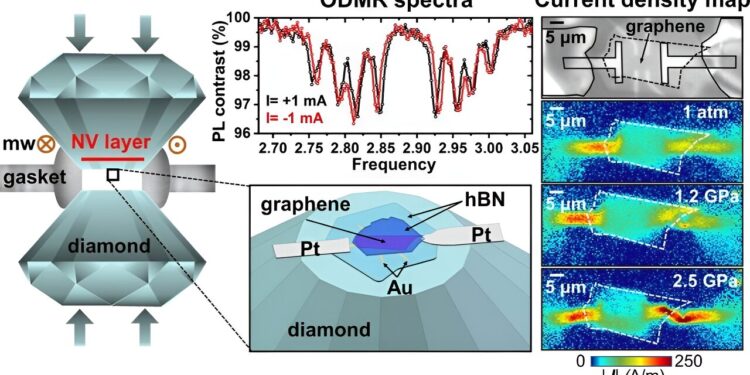Current density imaging and evolution of 2D hexagonal boron nitride (hBN)-graphene-hBN devices under high pressure. Credit: Nano Letters (2024). DOI: 10.1021/acs.nanolett.4c00780
A research team led by Professor Zhang Zengming from the University of Science and Technology of China (USTC), Chinese Academy of Sciences (CAS) combined nitrogen vacancy (NV) centers in diamond with a diamond anvil cell (DAC) to achieve noninvasive, high-resolution two-dimensional imaging of current density and pressure gradient for graphene devices under high pressure.
The team’s study is published in Nano Letters.
Many two-dimensional materials exhibit rich electronic properties under high pressure, such as pressure-induced superconductivity and topological phase transitions in twisted bilayer graphene (tBLG). However, traditional resistance measurements neglect crucial spatial information such as topological edge currents, impurities, and defects, which play essential roles in many fascinating physical phenomena.
Existing magnetic imaging techniques, such as superconducting quantum interference devices (SQUIDs), are limited by complex experimental conditions and limited spatial resolution, making them difficult to implement under high pressure. Therefore, there is an urgent need to develop experimental devices that can achieve noninvasive and high-resolution imaging of current density in two-dimensional devices under high pressure.
Diamond NV centers have been widely used to achieve two-dimensional current density imaging under ambient pressure due to their high sensitivity and spatial resolution. In addition, the combination of NV centers with DAC enables high-resolution magnetic imaging under high pressure. Based on this, the research team successfully combined NV centers with DAC to achieve noninvasive high-resolution two-dimensional current density imaging under high pressure.
In addition, they reconstructed the two-dimensional vector current density using the vector magnetic field mapped by the NV core layer near the diamond surface. The current density images accurately and clearly depicted the complex structure of graphene compressed under high pressure, such as the formation of cracks and holes, and the current flow. The spatial pressure distribution map extracted from the graphene device under high pressure provides a reasonable explanation for the non-uniformity of current density, such as variations in contact resistance and thickness.
This discovery opens a new avenue for exploring electronic transport and conductivity changes in two-dimensional materials and electronic devices under high pressure, as well as for the non-destructive evaluation of semiconductor circuits.
More information:
Cheng Zhong et al., High spatial resolution 2D imaging of current density and pressure for graphene devices under high pressure using nitrogen vacancy centers in diamond, Nano Letters (2024). DOI: 10.1021/acs.nanolett.4c00780
Provided by University of Science and Technology of China
Quote:Research team achieves high-resolution 2D imaging for graphene devices under high pressure (2024, September 9) retrieved September 9, 2024 from
This document is subject to copyright. Apart from any fair dealing for the purpose of private study or research, no part may be reproduced without written permission. The content is provided for informational purposes only.



